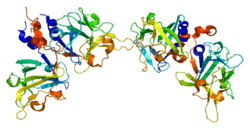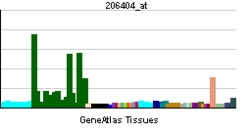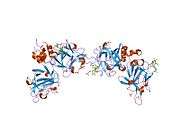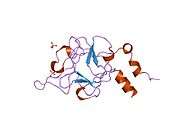FGF9
| View/Edit Human | View/Edit Mouse |
Glia-activating factor is a protein that in humans is encoded by the FGF9 gene.[3][4]
Function
The protein encoded by this gene is a member of the fibroblast growth factor (FGF) family. FGF family members possess broad mitogenic and cell survival activities, and are involved in a variety of biological processes, including embryonic development, cell growth, morphogenesis, tissue repair, tumor growth and invasion. This protein was isolated as a secreted factor that exhibits a growth-stimulating effect on cultured glial cells. In nervous system, this protein is produced mainly by neurons and may be important for glial cell development. Expression of the mouse homolog of this gene was found to be dependent on Sonic hedgehog (Shh) signaling. Mice lacking the homolog gene displayed a male-to-female sex reversal phenotype, which suggested a role in testicular embryogenesis.[4]
Interactions
FGF9 has been shown to interact with Fibroblast growth factor receptor 3.[5][6]
Role in sex determination
FGF9 has also been shown to play a vital role in male development. Once activated by SOX9, it is responsible for forming a feedforward loop with Sox9, increasing the levels of both genes. The absence of Fgf9 causes an individual, even an individual with X and Y chromosomes, to develop into a female, as it is needed to carry out important masculinizing developmental functions such as the multiplication of Sertoli cells and creation of the testis cords.[7]
References
- ↑ "Human PubMed Reference:".
- ↑ "Mouse PubMed Reference:".
- ↑ Miyamoto M, Naruo K, Seko C, Matsumoto S, Kondo T, Kurokawa T (Jul 1993). "Molecular cloning of a novel cytokine cDNA encoding the ninth member of the fibroblast growth factor family, which has a unique secretion property". Molecular and Cellular Biology. 13 (7): 4251–9. PMC 359975
 . PMID 8321227.
. PMID 8321227. - 1 2 "Entrez Gene: FGF9 fibroblast growth factor 9 (glia-activating factor)".
- ↑ Santos-Ocampo S, Colvin JS, Chellaiah A, Ornitz DM (Jan 1996). "Expression and biological activity of mouse fibroblast growth factor-9". The Journal of Biological Chemistry. 271 (3): 1726–31. doi:10.1074/jbc.271.3.1726. PMID 8576175.
- ↑ Chellaiah A, Yuan W, Chellaiah M, Ornitz DM (Dec 1999). "Mapping ligand binding domains in chimeric fibroblast growth factor receptor molecules. Multiple regions determine ligand binding specificity". The Journal of Biological Chemistry. 274 (49): 34785–94. doi:10.1074/jbc.274.49.34785. PMID 10574949.
- ↑ Kim Y, Kobayashi A, Sekido R, DiNapoli L, Brennan J, Chaboissier MC, Poulat F, Behringer RR, Lovell-Badge R, Capel B (Jun 2006). "Fgf9 and Wnt4 act as antagonistic signals to regulate mammalian sex determination". PLoS Biology. 4 (6): e187. doi:10.1371/journal.pbio.0040187. PMC 1463023
 . PMID 16700629.
. PMID 16700629.
Further reading
- Naruo K, Seko C, Kuroshima K, Matsutani E, Sasada R, Kondo T, Kurokawa T (Feb 1993). "Novel secretory heparin-binding factors from human glioma cells (glia-activating factors) involved in glial cell growth. Purification and biological properties". The Journal of Biological Chemistry. 268 (4): 2857–64. PMID 8428960.
- Mattei MG, Penault-Llorca F, Coulier F, Birnbaum D (Oct 1995). "The human FGF9 gene maps to chromosomal region 13q11-q12". Genomics. 29 (3): 811–2. doi:10.1006/geno.1995.9926. PMID 8575785.
- Santos-Ocampo S, Colvin JS, Chellaiah A, Ornitz DM (Jan 1996). "Expression and biological activity of mouse fibroblast growth factor-9". The Journal of Biological Chemistry. 271 (3): 1726–31. doi:10.1074/jbc.271.3.1726. PMID 8576175.
- Ornitz DM, Xu J, Colvin JS, McEwen DG, MacArthur CA, Coulier F, Gao G, Goldfarb M (Jun 1996). "Receptor specificity of the fibroblast growth factor family". The Journal of Biological Chemistry. 271 (25): 15292–7. doi:10.1074/jbc.271.25.15292. PMID 8663044.
- Nakamura S, Todo T, Haga S, Aizawa T, Motoi Y, Ueki A, Kurokawa T, Ikeda K (Jan 1997). "Motor neurons in human and rat spinal cord synthesize fibroblast growth factor-9". Neuroscience Letters. 221 (2-3): 181–4. doi:10.1016/S0304-3940(96)13312-7. PMID 9121694.
- Todo T, Kondo T, Nakamura S, Kirino T, Kurokawa T, Ikeda K (Feb 1998). "Neuronal localization of fibroblast growth factor-9 immunoreactivity in human and rat brain". Brain Research. 783 (2): 179–87. doi:10.1016/S0006-8993(97)01340-1. PMID 9507114.
- Giri D, Ropiquet F, Ittmann M (Jul 1999). "FGF9 is an autocrine and paracrine prostatic growth factor expressed by prostatic stromal cells". Journal of Cellular Physiology. 180 (1): 53–60. doi:10.1002/(SICI)1097-4652(199907)180:1<53::AID-JCP6>3.0.CO;2-P. PMID 10362017.
- Klein RD, Maliner-Jongewaard MS, Udayakumar TS, Boyd JL, Nagle RB, Bowden GT (Dec 1999). "Promatrilysin expression is induced by fibroblast growth factors in the prostatic carcinoma cell line LNCaP but not in normal primary prostate epithelial cells". The Prostate. 41 (4): 215–23. doi:10.1002/(SICI)1097-0045(19991201)41:4<215::AID-PROS1>3.0.CO;2-V. PMID 10544294.
- Chellaiah A, Yuan W, Chellaiah M, Ornitz DM (Dec 1999). "Mapping ligand binding domains in chimeric fibroblast growth factor receptor molecules. Multiple regions determine ligand binding specificity". The Journal of Biological Chemistry. 274 (49): 34785–94. doi:10.1074/jbc.274.49.34785. PMID 10574949.
- Plotnikov AN, Eliseenkova AV, Ibrahimi OA, Shriver Z, Sasisekharan R, Lemmon MA, Mohammadi M (Feb 2001). "Crystal structure of fibroblast growth factor 9 reveals regions implicated in dimerization and autoinhibition". The Journal of Biological Chemistry. 276 (6): 4322–9. doi:10.1074/jbc.M006502200. PMID 11060292.
- Hecht HJ, Adar R, Hofmann B, Bogin O, Weich H, Yayon A (Mar 2001). "Structure of fibroblast growth factor 9 shows a symmetric dimer with unique receptor- and heparin-binding interfaces". Acta Crystallographica Section D. 57 (Pt 3): 378–84. doi:10.1107/S0907444900020813. PMID 11223514.
- Tsai SJ, Wu MH, Chen HM, Chuang PC, Wing LY (Jul 2002). "Fibroblast growth factor-9 is an endometrial stromal growth factor". Endocrinology. 143 (7): 2715–21. doi:10.1210/en.143.7.2715. PMID 12072406.
- Alizadeh M, Miyamura N, Handa JT, Hjelmeland LM (Feb 2003). "Human RPE cells express the FGFR2IIIc and FGFR3IIIc splice variants and FGF9 as a potential high affinity ligand". Experimental Eye Research. 76 (2): 249–56. doi:10.1016/S0014-4835(02)00252-X. PMID 12565813.
- Wing LY, Chuang PC, Wu MH, Chen HM, Tsai SJ (Nov 2003). "Expression and mitogenic effect of fibroblast growth factor-9 in human endometriotic implant is regulated by aberrant production of estrogen". The Journal of Clinical Endocrinology and Metabolism. 88 (11): 5547–54. doi:10.1210/jc.2003-030597. PMID 14602803.
- Popovici C, Conchonaud F, Birnbaum D, Roubin R (Sep 2004). "Functional phylogeny relates LET-756 to fibroblast growth factor 9". The Journal of Biological Chemistry. 279 (38): 40146–52. doi:10.1074/jbc.M405795200. PMID 15199049.
- Fakhry A, Ratisoontorn C, Vedhachalam C, Salhab I, Koyama E, Leboy P, Pacifici M, Kirschner RE, Nah HD (Feb 2005). "Effects of FGF-2/-9 in calvarial bone cell cultures: differentiation stage-dependent mitogenic effect, inverse regulation of BMP-2 and noggin, and enhancement of osteogenic potential". Bone. 36 (2): 254–66. doi:10.1016/j.bone.2004.10.003. PMID 15780951.



